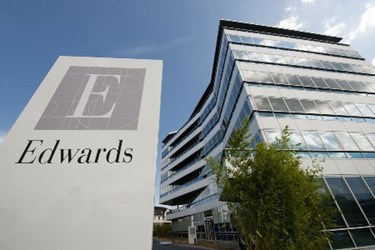Edwards Lifesciences Soars On Higher TAVR Sales, Sets Sights On Mitral And Tricuspid Therapies
By Jof Enriquez,
Follow me on Twitter @jofenriq

Edwards Lifesciences reported better-than-expected first quarter numbers behind surging sales of its transcatheter aortic valve replacement (TAVR) devices. The company expects the trend to continue and already is preparing to add mitral and tricuspid therapies to replicate its success with TAVR.
Overall sales soared 26.7 percent to $883.5 million behind Transcatheter Heart Valve Therapy (THVT) sales of $539.2 million, which was up 46.6 percent from the first quarter last year, including $298.8 million in the U.S. market, which grew 38.1 percent.
"Therapy adoption this quarter was strong, with continued growth in procedures across more than 500 hospitals. This growth continues to be driven by the extraordinary performance of our SAPIEN 3 valve and the growing body of evidence that supports excellent patient outcomes and faster recovery," company CEO Michael A. Mussallem told analysts during the earnings call.
In the U.S. alone, "We probably added more than 10 in Q1," he added. "We expect that number of centers to slowly increase. As a matter of fact, we've been kind of surprised that there's been an addition of these newly qualifying centers. So there is obviously a driving force and they've come up pretty fast and started to contribute to procedure growth."
Mussallem also said TAVR adoption in Europe was in line with expectations, and in Japan, more than 100 sites are now performing TAVR procedures, and more centers are being qualified.
In other business segments, Critical Care sales rose 8.4 percent to $144.8 million, and Surgical Heart Valve Therapy sales for the quarter grew 1.8 percent to $199.5 million, the company reported.
Mussallem said patient enrollment in the PARTNER III trial to implant SAPIEN 3 valves in severe aortic stenosis patients without diagnosed symptoms is ongoing, and screening could be completed by the end of the year.
"We really have focused our efforts on indication expansion with the existing device and think that that's more valuable than bringing a second platform right now," said Mussallem, referring to another TAVR platform being trialed called CENTERA. But he said the company will present the CENTERA trial data at next month's EuroPCR 2017 meeting, and hopefully receive the CE Mark and launch the product later this year.
Edwards' first quarter TAVR sales of 38 percent outpaced rivals, which grew 26 percent, wrote Canaccord analyst Jason Mills, who estimates that the company holds 67 percent share of the TAVR market, according to Investor's Business Daily. Other players in this space include Medtronic, Boston Scientific, Direct Flow Medical, and St. Jude Medical (now part of Abbott).
Eager to build off its success in TAVR, Edwards is seizing the opportunity to treat mitral and tricuspid patients with transcatheter therapies, beginning with multiple clinical trials this year.
Mussallem said the company is making product enhancements to the Cardioband system for transcatheter repair of the mitral and tricuspid valves through a transcatheter transseptal delivery system, and that the CE Mark clinical trial using this technology to treat tricuspid patients is on-track. He also anticipates CE Mark enrollment to start this year for the PASCAL transcatheter mitral valve repair system.
In addition, Mussallem said the company has resumed patient screening for the paused study testing its CardiAQ valve. The company halted the enrollment phase in February to "perform further design validation testing on a feature of our valve."
"Based on our current plans, we now expect a CE mark and commercial availability of a more refined system in 2019. We continue to believe CardiAQ with transseptal delivery is a very promising therapy for resolving patients' mitral regurgitation," said Mussallem.
"We've seen greater momentum across our emerging portfolio of mitral and tricuspid repair therapies and are very focused on the clinical development of each program," he told investors during the call.
